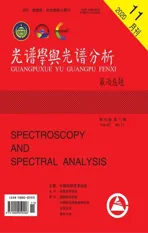Synthesis and Spectroscopic Characterizations of New Mercury(Ⅱ),Cerium(Ⅲ), and Thorium(Ⅳ) Captopril Drug Complexes
2020-11-05SamyElMegharbelMoamenRefat
Samy M. El-Megharbel,Moamen S. Refat
1. Department of Chemistry, College of Science, Taif University, P.O. Box 11099, Taif 21944, Saudi Arabia 2. Department of Chemistry, Faculty of Science, Zagazig University, Zagazig, Egypt 3. Department of Chemistry, Faculty of Science, Port Said University, Port Said, Egypt
Abstract In this article, three types of metal ions with different oxidation state as mercury(Ⅱ), cerium(Ⅲ) thorium(Ⅳ) have been reacted with captopril drug (CAP). The isolated solid complexes were explained using elemental analysis, conductance measurements, infrared and 1H-NMR spectroscopy as well as the thermo gravimetric (TG/DTG) analysis. The micro analytical and spectroscopic results for all CAP complexes were agreement with the speculated structures. The stoichiometry for divalent Hg2+, trivalent Ce3+ and tetravalent Th4+ metal ions with CAP ligand was established with 1∶2 (Mn+:CAP) molar ratio. The qualitative analysis showed that in case of the mercury(Ⅱ) complex, the chloride ions didn’t involved in the complexity, suggesting formula [Hg(CAP)2] in neutral form. However, regarding both Ce(Ⅲ) and Th(Ⅳ) complexes as [Ce(CAP)2(NO3)]·3H2O and [Th(CAP)2(NO3)2(H2O)]·3H2O formulas, the nitrate group is existed inside the coordination sphere. The infrared analysis data proved that CAP drug act as a bidentate ligand with the metal ions of Ce(Ⅲ) and Th(Ⅳ) through oxygen carbonyl group group and sulfur atom of the deprotonated —SH group. Thorium(Ⅵ) complex has a nine-coordinate geometry, while Hg(Ⅱ) and Ce(Ⅲ) have a four and six-coordination behaviors respectively. The 1H-NMR data of the CAP compound has a singlet sharp signal at 1.90 ppm due to the proton of —SH group, this peak absent in the spectrum of the Hg(Ⅱ) CAP complex upon the deprotonated of thiol group.
Keywords Captopril drug; Metal ions; FTIR; 1H-NMR
Introduction


Fig.1 Structure of captopril drug
1 Experimental
Captopril used was received from the Aldrich Chemical Company. Chemicals used for this study were of analytically reagent grade, commercially available from BDH like HgCl2, Ce(NO3)3·6H2O and Th(NO3)4·5H2O.
1.1 Synthesis
The Hg(Ⅱ), Ce(Ⅲ) and Th(Ⅳ) complexity were prepared by reaction of HgCl2, Ce(NO3)3·6H2O and Th(NO3)4·5H2O metal ions with (1 mmole) in 25 mL distilled water to dissolved Captopril (25 mL of 99% CH3OH) with molar ratio 1∶2. The pH of Captopril metal ions mixtures are between ~8.0~9.0 using 5% ammonium hydroxide. The product was stirred and refluxed at 70 ℃ for 3 h. The obtained precipitates were filtered off and washed with distilled water and CH3OH. The solid product precipitates were dried at 70 ℃ under vacuum over anhydrous calcium chloride.
1.2 Instruments
The C, H and N percentage determined using Vario EL Fab. CHNS. Metal content and water percentage were determined by TG/DTG. IR data for CPA complexity were measured using infrared Bruker spectrophotometer ranged between 400~4 000 cm-1. The conductance measurements with concentration of 10-3mol·L-1for complexity in dimethyl sulfoxide solvent measured using HACH conductivity meter model.1H-NMR was recorded as dimethyl sulfoxide solutions on a Bruker 600 MHz spectrometer using tetramethyl silane as the internal standard. TGA experiments were conducted using Shimadzu TGA-50H thermal analyzers. All experiments were performed using a single loose top loading platinum sample pan under N2atmosphere at a flow rate of 30 mL·min-1and a 10 ℃·min-1heating rate for the temperature range 25~800 ℃.
2 Results and Discussion
C, H and N percentage of the new three complexity were in Table 1. The data of elemental analysis show that (metal : CAP) molar ratio were of 1∶2 for Ce(Ⅲ), Th(Ⅳ) and Hg(Ⅱ). These complexity didn’t completely soluble in hot DMSO and DMF, but insoluble in H2O and other organic solvents. The suggested formula structures of the complexity were based on the results of the elemental analyses, molar conductivity, (infrared,1H-NMR) spectra and the thermal analysis. The degradation profile and thermal stability of the CAP complexes were investigated by thermogravimetric (TG) measurements. The Hg-CAP showed good thermal stability compared with other complexes. The TG and DTG indicted that Th/CAP, Ce/CAP and Hg/CAP are thermally stable up to 80, 100 and 235 ℃, respectively. Th(Ⅳ) and Ce(Ⅲ) complexes were thermally decomposed within five and four steps respectively while for Hg(Ⅱ) complexity decomposed within two steps. The thermogram of the Th and Ce/CAP complxes indicate that the most stable final product of the thermal degradation was metal oxide contaminated with carbon atoms.

Table 1 Analytical and physical data of the CAP complexes
2.1 Molar conductance

2.2 Infrared Spectra


Fig.2(a) FTIR spectrum of Hg(Ⅱ) CAP complex

Fig.2(b) FTIR spectrum of Ce(Ⅲ) CAP complex

Fig.2(c) FTIR spectrum of Th(Ⅳ) CAP complex

Table 2 Infrared spectral bands and assignments of CAP complexes



Fig.3 Speculated structures of Hg(Ⅱ), Ce(Ⅲ) and Th(Ⅳ) captopril complexes
2.3 1H-NMR spectra
The1H-NMR spectral analyses for CAP compound in DMSO-d6has a singlet sharp signal at 1.90 ppm referred to the proton of —SH, this signal not found in the spectrum of the Hg-CAP complexity due to the deprotonation of the —SH group. The non-equivalent protons of pyrrolidine ring —CH2protons, appear as at 2.48~2.51 ppm. The1H-NMR spectral analyses of the CAP ligand has a singlet sharp signal at 8.53 ppm attributed to the proton of —COOH, this signal not affected in spectrum of the Hg/CAP complexity, supported that carboxylic group not involved in the coordination. These facts confirms the coordination site of captopril which discussed above.
